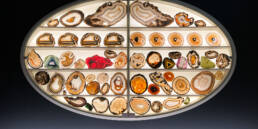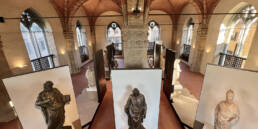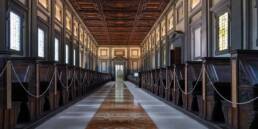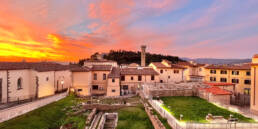Palazzo Strozzi and the Bargello Museums present “Donatello, The Renaissance”, a historic international exhibition in Florence. The title is printed in non-serif all caps on posters around the city and poignantly embossed in low-relief on the hefty hardback catalogue with a kind of authority, of definitiveness, rarely seen in the modern age. It’s not “Donatello and the Renaissance” – in which we’d expect a few Donatellos and lots of works “after Donatello”; the juxtaposition of the artist’s name and the period he represents is an assertion. Donatello. IS. The. Renaissance, the curator insists. Looking back with confidence at the artist who defined an era and everything after it feels comforting in this new age of uncertainty.

The show begins with a bang at Palazzo Strozzi. I’m not a gushy type of viewer, trained as I am as a scholar, but from room to room, I literally gasped at the curator’s audaciousness in procuring seemingly impossible loans including huge sculptures, some of which are centrepieces of important churches, in order to create unparalleled comparisons in an almost complete monographic exhibition. In the first room alone, we have Donatello’s marble David from the Bargello flanked by two crucifixes that are part of Vasarian lore; Vasari says that Brunelleschi criticized Donatello’s crucifix for Santa Croce and made a better one himself for Santa Maria Novella. This room, which speaks of Donatello’s auspicious beginnings and of the importance of his friendship with the inventor of perspective, also seems to declare the importance of this exhibition and the fact that you could only ever pull this off in Florence.

The following room also seems to say “go big or go home” with the juxtaposition of Donatello’s Saint Louis of Toulouse from Santa Croce with the equally golden Reliquary of Saint Rossore from Pisa. The Santa Croce sculpture is placed lower here than it is in the museum across town so we can get a really good look at its clever construction: it was cast in numerous pieces that give the impression of depth and volume while actually being an empty shell.

Then we have the bronze doors from the Sacristy of San Lorenzo – one of which was restored for the exhibition and the other to be restored right after; as well as numerous sculptures and low reliefs loaned from the Basilica of Sant’Antonio in Padova, an important and active pilgrimage site in which these works are integral. No less important, but not requiring loan agreements or transportation, are the masterpieces that reside permanently in the Donatello Room at the Bargello, where the exhibition continues.

But this is not just a show about monumental sculpture, and that’s why I like it so much. Curator Francesco Caglioti’s literature review demonstrates admiration for Horst W. Janson’s The Sculpture of Donatello (published by Princeton University Press in 1963); on a personal note, my own cherished copy was purchased used from the Newberry Library and bears the insignia of the late Michael Camille, a young, creative professor under whom I’d hoped to study for my PhD at the University of Chicago but who tragically passed away just as I arrived. Janson, following the notes of Jenö Lányi, catalogued his accepted and rejected works by Donatello and remains the most substantial contribution to the literature on the artist, however, as the curator points out, “many changes have been made in the meantime, both on the cataloguing front and on that of interpretation.” Caglioti reminds us of Donatello’s frequent collaborations with other artists for major projects like the pulpit in Prato or the chancel of the Basilica del Santo in Padua that expand our vision of Donatello. But even more important to understanding the whole of the artist’s impact on his era are the smaller, spirited and more private works that actually find their place in this exhibition.

Besides monumental saints, Donatello and his workshop dedicated a lot of time to (and probably received good cash-flow from) the production of charming Madonna and Child figures that were a household staple in middle-class Renaissance Florence. I was pleased to see a proportionally large amount of space, both at Palazzo Strozzi and at the Bargello, dedicated to this output.

The compositions of these works, in a range of media from terracotta or stucco to carved wood and delicate low-relief marble, was highly influential on Donatello’s contemporaries. The most precious of these works are certainly those in marble relief, and here there are many: to cite only the most powerful, the Madonna of the Clouds from Boston, the Dudley Madonna from the V&A, the Madonna of the Stairs from Casa Buonarroti (just restored) and the Pazzi Madonna on loan from Berlin. The intimacy of these scenes is augmented by their medium; they are small and monochromatic, and since they don’t have much depth, you need to lean in to experience them. These works are important because they cross the line between sculpture and painting in order to capture the best of both worlds, incorporating new ideas about perspective that were being developed by both Brunelleschi and Donatello at the time.

This groundbreaking use of perspective found its way into the backgrounds of the devotional Madonnas that Donatello’s workshop produced in easily replicable media like stucco casts which would be then varied through polychromy. As such, this style was widely diffused and taken up by other artists, I’d like to think perhaps at the request of patrons who appreciated the new style. I tend to think that these plaster casts and many Madonnas established Donatello’s fame perhaps more than any important yet immovable big bronze saint could do; they play a popularizing role in the same way as, one hundred years later, Marcantonio Raimondi’s prints of Raphael’s frescoes would diffuse the High Renaissance master’s motifs well beyond Rome and across Europe.
Amongst the themes deemed worthy of exhibition space, I was surprised to see two rooms dedicated to Spiritelli, Donatello’s interpretation of those naked winged children that many of us call putti. This section seems to recognize the contribution to Donatello scholarship made by Charles Dempsey with the publication of his 2001 book Inventing the Renaissance Putto (although oddly I’m not seeing it cited in the bibliography) and the catalogue essay by Neville Rowley would have very much excited me had it been published while I was working on my 2007 dissertation that just happened to be about the role of putti in art.

Dempsey interprets putti only as “sprites” and considered that they embodied a minor demon causing variations of love and fright; based on this, he re-interpreted some key works of the Renaissance. My take on putti was wider; I demonstrated that putti left the margins to come to the centre of meaning through sixteenth-century prints. Helped by the cheaper and less weighty medium, we see putti in starring roles at the centres of compositions, while earlier, like in the sculpture of Donatello, they serve to reflect or direct the viewer’s own emotions. Demonstrating this perfectly in the exhibition is the comparison of four works stemming from two Donatello reliefs of Imago Pietatis in which mourning putti at either side of Christ hold their faces in desperation: their outright grief signals the viewer’s reaction.

I thus found it interesting to consider the role played by the many putti in this exhibition, some of which I’d made significant treks to see back in my grad student days, like the Paris Spiritelli Candle-Holders for Luca della Robbia’s Cantoria (Musée Jacquemart-André), considered “among Donatello’s most extraordinary inventions” (cat. p. 200). One of my first encounters with Prato was for the putto-studded pulpit that sits on a corner of the city’s Cathedral, a collaboration between Donatello and Michelozzo, which has been moved to Palazzo Strozzi for the exhibition. Even more incredible is the loan of the jewel-box-like reliquary made by Maso di Bartolomeo to hold the Holy Girdle of the Virgin Mary, the most precious relic of Prato, whose tiny ivory dancing putti mimic the Donatello reliefs of the pulpit, an absolute gem that shows the depth of Donatello’s influence across media.

The exhibition “Donatello, The Renaissance” clearly represents massive collaboration amongst museums and institutions; the show will travel, with variations on the loans, to the Staatliche Museen in Berlin and the Victoria and Albert Museum in London. The 450-page catalogue will also come out in different editions for each show. With extensive loans of key works from the Bargello, it’s hard to imagine that versions in other cities will be quite as extensive as the Florence one, and I’m convinced that this is a show best seen here. For those who can’t make it this year, the catalogue will be a must in library collections where it makes a significant contribution to art historical literature.
Visitor Information
Donatello, The Renaissance
Palazzo Strozzi and Museo Nazionale del Bargello
March 19 to July 31, 2022
Curated by Francesco Caglioti
Sign up to receive future blog posts by email
Alexandra Korey
Alexandra Korey aka @arttrav on social media, is a Florence-based writer and digital consultant. Her blog, ArtTrav has been online since 2004.
Related Posts
January 30, 2024
Florence Museum News 2024
January 5, 2024
The Architecture of Michelangelo’s Laurentian Library
July 19, 2023




